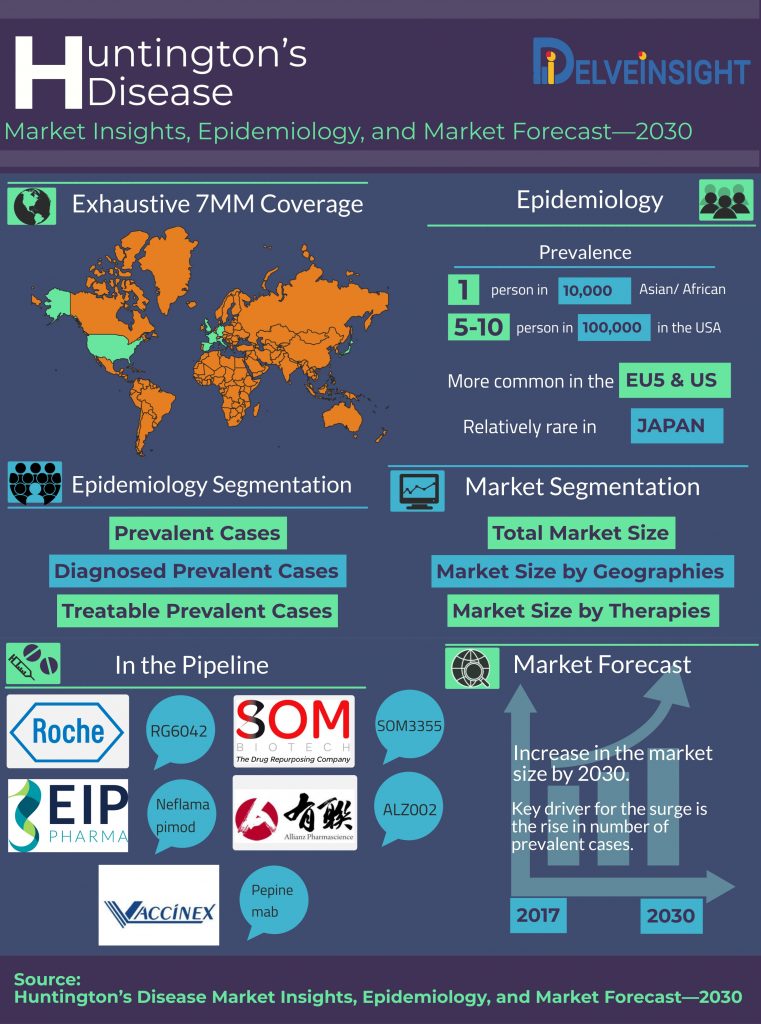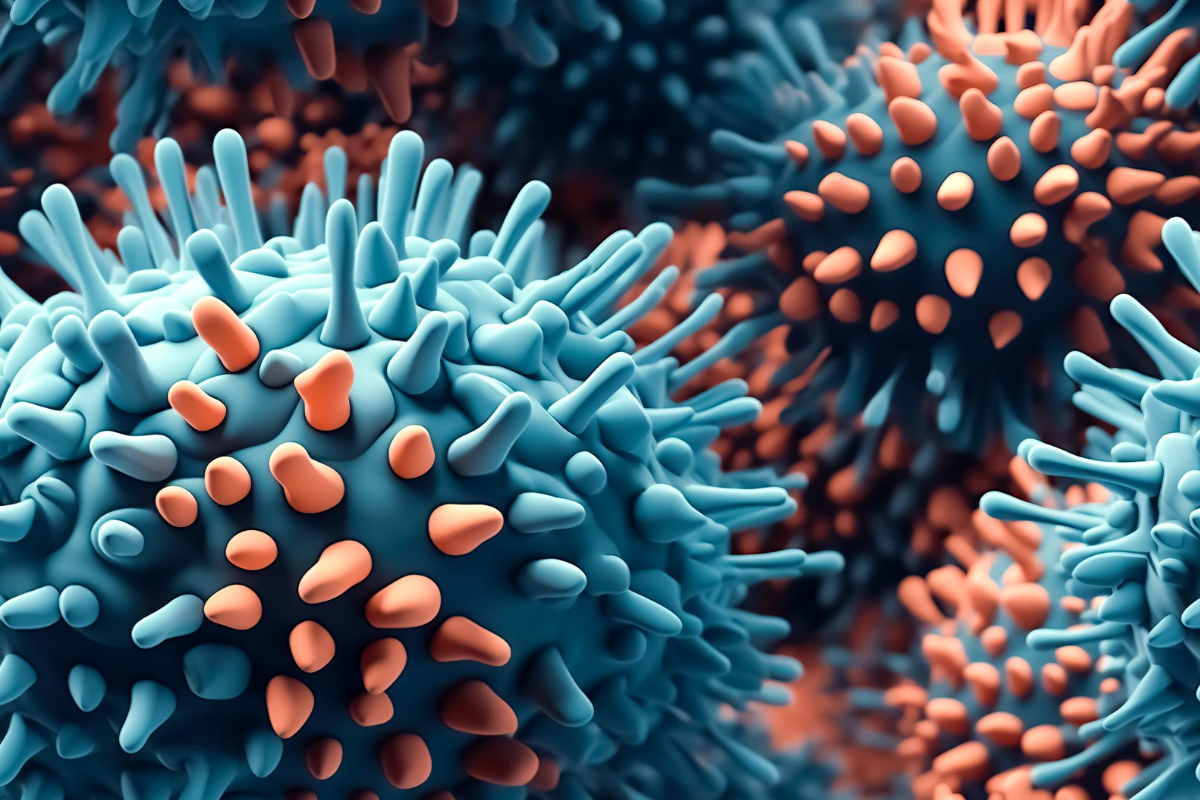Is the cure for Huntington’s disease on the horizon?
May 11, 2020
Several promising new developments and novel treatment approaches are fuelling Huntington’s disease Market.
Progressive neurological disorders such as Parkinson disease (PD), motor neuron disease (MND), Huntington disease (HD), or multiple sclerosis (MS), despite the advent of technological advances in healthcare and medical sciences, poses a huge burden worldwide, which is set to increase in coming decades.
The global need of resources for managing neurological diseases has remained unmet for so long that the absolute number of people, dying or living with disability due to neurological disorders, have increased substantially in the last three decades. Several times, due to associated psychological issues with the brain-related diseases tend to result in attempting suicides by the patients such as in Huntington’s disease. Risk of suicide in Huntington’s disease remains highest, which is also one of the reasons for premature deaths in Huntington’s disease.
Huntington disease (HD) is an autosomal-dominant neurodegenerative disease characterized by cognitive disturbance, motor abnormalities, and psychiatric symptoms. It is an orphan disease that is inherited genetically and results in a progressive breakdown of the nerve cells. The disease impacts the person’s ability to move, think affecting the person psychologically.
Downloads
Click Here To Get the Article in PDF
Recent Articles
- NIH awards $107M for COVID-19 testing tech; GSK secures rights; Roche’s bispecific matches ...
- Roche’s Vabysmo Third US Approval Spiced Up the Battle With Regeneron and Bayer’s Eylea
- Is the Cure for Duchenne Muscular Dystrophy in the Pipeline?
- Roche’s drug; Cancer drugs risk; FDA norms; Takeda sets deal
- Glaxo replaces ViiV; Lilly nets; AstraZeneca shuffles off; Gazyva aims to beat
The disease is a result in mutation in the HTT gene responsible for encoding for huntingtin protein whose excess build-up is considered to be a marker while diagnosing the disease. Moreover, as per the recent research in the field it was discovered that the number of CAG repeats in the huntingtin protein are also associated with prognosis of the disease.
Huntington disease degrades the life-quality of an estimated 3 to 7 per 100,000 people of European ancestry as per NIH. The numbers in the US range from 4.1-8.4 per 100,000 people estimated a study by S.E.Folstein et al. However, several studies agreed upon a relatively lower preponderance of Huntington’s disease in populations of Japanese, Chinese, and African descent.
As per a study by Swierzewski et al. titled “Huntington’s Disease Overview, Incidence and Prevalence of HD,” 1 in every 10,000 persons (that accounts for nearly 30,00 people) in the United States are living with Huntington’s disease. Moreover, Juvenile Huntington’s disease occurs in approximately 16% of all the cases. According to another study conducted by Wexler et al. titled “Incidence of adult Huntington’s disease in the UK: a UK-based primary care study and a systematic review,” the Huntington’s disease prevalence, as diagnosed and recorded in primary care records, has increased from 5.4 per 100,000 in 1990 to 12.3 per 100,000 in 2010 explaining that the occurrence of the disease has increased two-fold in these years.
The rise in the prevalence of Huntington’s disease forms the major driving forces behind the advancing Huntington’s disease market, says DelveInsight.
Huntington’s disease Market and Unmet needs
At present, Huntington’s disease market has no effective treatment that can halt or delay the progression of the disease. Till date, Huntington’s disease remains incurable. No treatments available can alter the course of the disease, however, medications can lessen some symptoms of movement and psychiatric disorders. Only FDA-approved drug involved to treat chorea associated with Huntington’s disease, which is the most notable known symptom, is Tetrabenazine (Xenazine), which is again a symptomatic approach to manage the disease. Other medications that are symptomatic in nature include antipsychotic drugs such as haloperidol (Haldol) and chlorpromazine, and other medications such as amantadine, levetiracetam (Keppra), and clonazepam (Klonopin) that help to alleviate the symptoms.
Moreover, to target the psychiatric symptoms medications such as antidepressants including citalopram (Celexa), escitalopram (Lexapro), fluoxetine (Prozac, Sarafem), and sertraline (Zoloft); antipsychotic drugs including quetiapine (Seroquel), risperidone (Risperdal) and olanzapine (Zyprexa) followed by mood-stabilizing drugs namely valproate (Depacon), carbamazepine (Carbatrol, Epitol, Tegretol) and lamotrigine (Lamictal) are also prescribed to Huntington’s disease patients.
However, several promising new developments and novel treatment approaches prove to be potential in improving the lives of Huntington’s disease patients, reducing the risk of hereditary transfer and fuelling Huntington’s disease Market.
RG6042 by Roche, Neflamapimod under development by Vertex and EIP pharma, Pepinemab of Vaccinex, SOM3355 of OM Biotech SL and ALZ002 of Allianz Pharma are some of the emerging pipeline products in the Huntington’s disease market. Several companies such as Hoffmann-La Roche (RG6042), EIP Pharma (Neflamapimod), Vaccinex (Pepinemab), and SOM Biotech SL (SOM3355) and others are in the process of developing multiple-stage products that have the potential to create a significant positive shift in the Huntington’s disease market Size.
With trials testing immunotherapies to target the mutation, using antisense oligonucleotides (ASOs), and other drugs that are approved or thought to have had the potential to treat other diseases, the Huntington’s disease market scenario looks quite optimistic enough to the point that soon enough Huntington’s disease would be manageable and have standard treatment options.
Downloads
Article in PDF
Recent Articles
- Notizia
- HR+/HER2- Breast Cancer: Unveiling the Worldwide Advances and Strategies
- Roche, Boehringer tout; Pfizer, Bristol-Myers got sued; FDA commissioner unveils; EpicGenetics ex...
- Next Generation Antibody-Drug Conjugate Therapeutics and Market Analysis
- 4D Molecular Therapeutics raises; Arvinas slates for IPO; Sutro ruminates for $ 75M; Emergent Bio...




